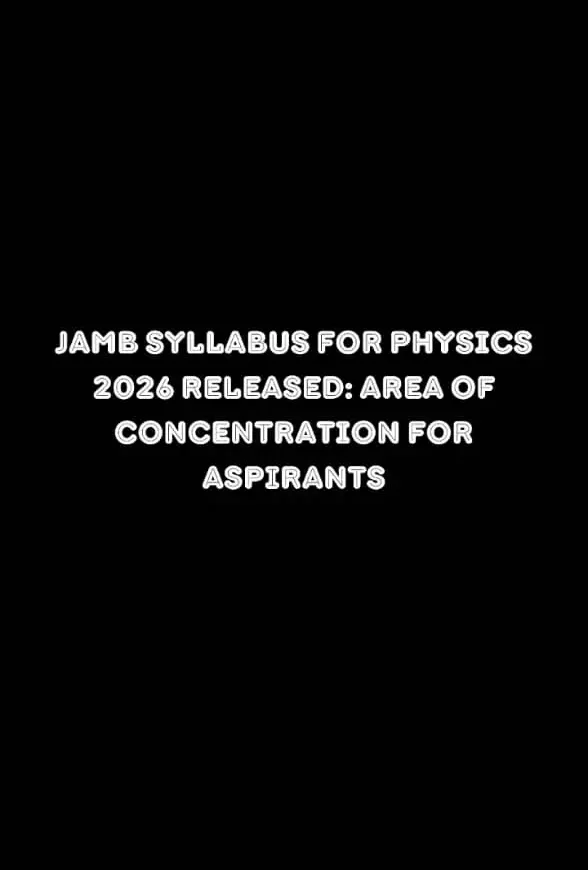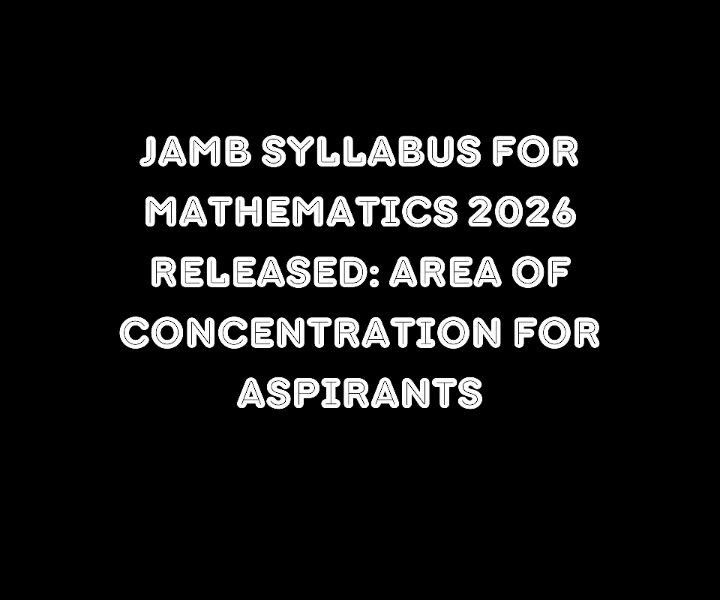Every year, when JAMB releases a new syllabus, thousands of students take a deep breath, some will be excited while others would panic. And if you’re reading this, chances are you’re one of the determined few who want to get it right this time.
Let’s be honest, Physics is not your average subject. It’s not one of those courses you can just “cram overnight and pass.” Nope. Physics demands understanding, reasoning, and a little bit of love for how the world actually works.
So, as you have the JAMB Syllabus for Physics 2026, it isn’t just another update, but a guide that shows you exactly what JAMB expects you to know, what areas to focus on, and how to prepare well
What’s New in the 2026 Physics Syllabus?
1. Increased Focus on Modern Physics
JAMB is slowly shifting toward more contemporary physics concepts, topics that reflect how science is evolving globally. You’ll see more emphasis on areas like atomic physics, nuclear energy, and quantum basics. This means questions won’t just come from classical areas like motion and waves, you might face modern, real-world scenarios too.
2. Renewable Energy and Environmental Awareness
For the first time, there’s a subtle mention of renewable energy, solar technology, and energy efficiency. Why? Because the world is moving green, and Physics plays a huge role in that. You might encounter questions that test your understanding of solar cells, energy conversion, and even how Physics supports sustainable development.
3. Data-Based and Analytical Questions
Gone are the days when JAMB asked straightforward “definition” questions. The 2026 syllabus expects you to think. Questions are likely to come in problem-solving format, often tied to real-life applications, like “why car brakes heat up” or “why an iron rod expands in heat.”
4. Refined Practical Components
The practical section now emphasizes not just experiments but interpretation. It’s not enough to know the procedure, you should also understand what the result means and how it connects to real-world physics.
How to Study the Physics JAMB Syllabus Effectively
Alright, let’s get practical.
Reading the syllabus is one thing; but using it strategically is another. Here’s how you can approach the JAMB Physics 2026 syllabus like a complete boss
1. Break It Down, Topic by Topic
Don’t just print the syllabus and toss it aside. Go through it line by line. Divide the topics into sections, for example:
Mechanics (Motion, Forces, Energy)
Waves and Optics (Sound, Light, Lenses)
Electricity and Magnetism
Modern Physics (Atoms, Nuclear Physics, Quantum ideas)
2. Study Smart, Not Hard
Physics rewards understanding, not memorization.
Instead of trying to “cram” the entire formula sheet, understand how each formula works. For instance, if you know the logic behind , you can apply it in any motion question, no matter how it’s twisted.
3. Use the JAMB Past Questions Strategically
Many aspirants make the mistake of using past questions just for practice. Big mistake.
Here’s the secret: Past questions are JAMB’s mind revealed.
Study how they repeat certain patterns. JAMB may twist a question, but the principle behind it often remains the same.
4. Leverage Visual Learning
Not everyone learns by reading thick textbooks. Use YouTube channels that simplify Physics concepts, animations that explain light and motion, or mobile apps that turn formulas into visual examples.
(If you can visualize it, you can remember it.)
5. Create a Formula Journal
Have a small book for all formulas, not just written down, but explained. Write what each symbol stands for, when to use it, and examples where it applies. This makes revision faster and stronger.
6. Practice, Practice, Practice
Physics is a problem-solving subject. Spend more time solving than reading.
Do at least 20–30 questions daily. By exam month, you’ll have encountered every question pattern JAMB can throw at you.
7. Test Yourself Regularly
Don’t wait for mock exams. Test yourself weekly using CBT apps or group quizzes.
Simulate real exam pressure, time yourself, avoid distractions, and review mistakes immediately.
8. Be Curious
This is one thing most students ignore. If you study why the sky is blue, or why your fan slows down when voltage drops, you’re already doing Physics, and that curiosity will make you unbeatable.
JAMB Syllabus for Physics 2026
Every JAMB candidate knows that the moment the JAMB Syllabus for Physics 2026 is released, it’s like getting the exam’s cheat map, as you get a peek into exactly what to expect. It’s not something to or ignore.
Now, what exactly does the 2026 Physics syllabus contain?
It outlines all the topics JAMB expects you to understand under major branches of Physics, Mechanics, Waves, Heat, Electricity, Magnetism, Modern Physics, and more. But it’s not just a list; it’s a guide that defines the depth of understanding required.
Here’s a simplified breakdown of what you’ll find in it
1. Mechanics
This is one of the most important areas of Physics, and JAMB knows it. Expect questions around:
Motion (linear, circular, projectile)
Newton’s laws
Energy and momentum
Simple machines
Equilibrium of forces
Center of gravity and moments
2. Thermal Physics (Heat)
You’ll need to understand concepts like:
Expansion of solids and liquids
Calorimetry
Gas laws (Boyle’s, Charles’s, and Pressure laws)
Kinetic theory
Heat transfer (conduction, convection, radiation)
3. Waves and Optics
This section is always interesting. Topics include:
Sound waves
Reflection and refraction of light
Lenses and mirrors
Dispersion and color
The human eye and optical instruments
This part is both theoretical and practical, so be ready for numerical and diagram-based questions.
4. Electricity and Magnetism
Now we’re diving into one of JAMB’s trickiest areas.
You’ll meet:
Electric fields and current
Ohm’s law and resistors
Series and parallel circuits
Electromagnetism and transformers
Capacitors and simple electronics
5. Modern Physics
This is where the syllabus gets futuristic, and fun.
Here, you’ll see:
Atomic structure and the Bohr model
Radioactivity
Nuclear energy
Photoelectric effect
6. Practical Physics
Yes, the practical section is still very relevant.
You’re expected to know how to:
Measure physical quantities using instruments like vernier calipers, micrometer screws, and meter rules
Interpret experimental results
Plot graphs
Calculate slope, intercept, and deduce relationships between physical quantities
Also Read: Newly Released Jamb Syllabus For English 2026: Area of Concentration
Recommended Textbooks and Tools for the 2026 Physics Syllabus
1. New School Physics by M.W. Anyakoha
If you’re serious about scoring high, this is your holy grail.
This book has been the backbone of Physics preparation in Nigeria for years. It explains concepts clearly, provides plenty of worked examples, and aligns perfectly with the JAMB syllabus.
It’s like having a personal tutor in your hand. If you can go through this book twice before your exam, you’ll understand 80% of what JAMB expects.
2. Senior Secondary Physics by P.N. Okeke and M.N. Okeke
Another classic, it’s simple, student-friendly, and packed with illustrations.
This book helps you build a strong conceptual foundation and breaks complex topics like waves and electricity into easy, digestible lessons.
3. Essential Physics for Senior Secondary Schools by L.A. Lawal
This one is great if you like a more direct, exam-focused approach. It’s concise and straight to the point, perfect for quick revision when exams are close.
Use it to review after reading from a more detailed textbook.
4. University Physics by Sears and Zemansky (for the Curious Mind)
If you’re the type who likes understanding why things happen, not just how, this book is for you. It’s a bit advanced, but it gives deep insights that make you appreciate Physics as more than just exam material.
5. JAMB-Approved Past Questions and Answers
Never underestimate this.
Past questions are your best mirror into JAMB’s thinking pattern. Get a good CBT app or hard copy that provides explanations, not just answers, and practice consistently.
Conclusion
The JAMB Syllabus for Physics 2026 is your best guide.
The recommended textbooks and tools are your weapons.
How you use them will determine your success.
Instead of being overwhelmed by how vast Physics is, approach it one topic at a time, with curiosity and consistency. You don’t need to study 10 hours a day, you just need to study smart.
And always remember that Physics is not about numbers, it’s more about understanding how the universe works.
Once you see it that way, studying becomes a fascinating adventure.


